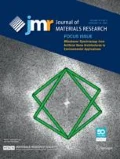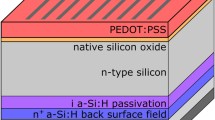Abstract
Degradation in PEDOT:PSS-silicon hybrid heterojunction solar cells is centered at the organic–silicon interface characterized by an s-shaped JV curve. The effects of interfacial silicon oxide and the degradation of PEDOT:PSS films on solar cell performance were simulated and fit to experimental results and found to be good predictors of JV performance and the development of s-shapes. Transmission line measurement (TLM) studies showed the Ag-PEDOT:PSS interface remains ohmic over 5 weeks and has a contact resistivity < 0.1ohm cm2 over 10 days. X-ray photoelectron spectroscopy (XPS) showed that the interfacial silicon oxide develops rapidly after fabrication with high amounts of suboxide defects that grows and chemically saturates to the native oxide thickness (1.5 nm) and composition as the devices age. Hard X-ray photoelectron spectroscopy (HAXPES) was used to investigate the buried organic–silicon interface and showed that doping in the PEDOT:PSS backbone decreases and the PEDOT:PSS-silicon band alignment does not change measurably as the devices age.
Graphical abstract










Similar content being viewed by others
References
J.P. Thomas, K.T. Leung, Defect-minimized PEDOT:PSS/planar-si solar cell with very high efficiency. Adv. Funct. Mater. 24(31), 4978–4985 (2014)
J.Y. Kim, J.H. Jung, D.E. Lee, J. Joo, Enhancement of electrical conductivity of poly(3, 4-ethylenedioxythiophene)/poly(4-styrenesulfonate) by a change of solvents. Synth. Met. 126(2–3), 311–316 (2002)
J.P. Thomas, L. Zhao, D. McGillivray, K.T. Leung, High-efficiency hybrid solar cells by nanostructural modification in PEDOT:PSS with co-solvent addition. J. Mater. Chem. A 2(7), 2383–2389 (2014)
C. Badre, L. Marquant, A.M. Alsayed, L.A. Hough, Highly conductive poly(3,4-ethylenedioxythiophene): Poly (styrenesulfonate) films using 1-ethyl-3-methylimidazolium tetracyanoborate ionic liquid. Adv. Funct. Mater. 22(13), 2723–2727 (2012)
J. He et al., Silicon/Organic Hybrid Solar Cells with 16.2% Efficiency and Improved Stability by Formation of Conformal Heterojunction Coating and Moisture-Resistant Capping Layer. Adv. Mater. 29(15), 1–7 (2017)
D. Zielke, C. Niehaves, W. Lövenich, A. Elschner, M. Hörteis, J. Schmidt, Organic-silicon solar cells exceeding 20% efficiency. Energy Procedia 77, 331–339 (2015)
R. Saive, S-shaped current–voltage characteristics in solar cells: a review. IEEE J. Photovoltaics 9(6), 1477–1484 (2019)
U. Das, S. Hegedus, L. Zhang, J. Appel, J. Rand, R. Birkmire, Investigation of hetero-interface and junction properties in silicon heterojunction solar cells, in Conf. Rec. IEEE Photovolt. Spec. Conf., pp. 1358–1362 (2010)
S. Kirchmeyer, A. Elschner, K. Reuter, PEDOT: Principles and Applications of an Intrinsically Conductive Polymer (CRC, Boca Raton, 2010).
S. Jäckle et al., Junction formation and current transport mechanisms in hybrid n-Si/PEDOT:PSS solar cells. Sci. Rep. 5, 1–12 (2015)
S. Jäckle et al., Potential of PEDOT:PSS as a hole selective front contact for silicon heterojunction solar cells. Sci. Rep. 7(1), 1–8 (2017)
J. Rivnay et al., Structural control of mixed ionic and electronic transport in conducting polymers. Nat. Commun. 7, 1–9 (2016)
M. Pietsch, M.Y. Bashouti, S. Christiansen, The role of hole transport in hybrid inorganic/organic silicon/poly(3,4- ethylenedioxy-thiophene):poly(styrenesulfonate) heterojunction solar cells. J. Phys. Chem. C 117(18), 9049–9055 (2013)
M. Chen, J.H. Hack, A. Iyer, K.J. Jones, R.L. Opila, Radical-driven silicon surface passivation by benzoquinone- and hydroquinone-methanol and photoinitiators. J. Phys. Chem. C 121(39), 21364–21373 (2017)
L. He, C. Jiang, H. Wang, D. Lai, Rusli, High efficiency planar Si/organic heterojunction hybrid solar cells. Appl. Phys. Lett. 100(7), 1–4 (2012)
R. Varache, C. Leendertz, M.E. Gueunier-Farret, J. Haschke, D. Muñoz, L. Korte, Investigation of selective junctions using a newly developed tunnel current model for solar cell applications. Sol. Energy Mater. Sol. Cells 141, 14–23 (2015)
J.P. Thomas, L. Zhao, M. Abd-Ellah, N.F. Heinig, K.T. Leung, Interfacial micropore defect formation in PEDOT:PSS-Si hybrid solar cells probed by TOF-SIMS 3D chemical imaging. Anal. Chem. 85(14), 6840–6845 (2013)
J. Schmidt, V. Titova, D. Zielke, Organic-silicon heterojunction solar cells: Open-circuit voltage potential and stability. Appl. Phys. Lett. 103(18), 1–5 (2013)
J. Sheng et al., Improvement of the SiOx passivation layer for high-efficiency Si/PEDOT: PSS heterojunction solar cells. ACS Appl. Mater. Interfaces 6(18), 16027–16034 (2014)
M. Junghanns, J. Plentz, G. Andrä, A. Gawlik, I. Höger, F. Falk, PEDOT:PSS emitters on multicrystalline silicon thin-film absorbers for hybrid solar cells. Appl. Phys. Lett. 106(8), 18–21 (2015)
S. Jäckle et al., Unveiling the Hybrid n-Si/PEDOT:PSS Interface. ACS Appl. Mater. Interfaces 8(13), 8841–8848 (2016)
S.M.A. Durrani, M.F. Al-Kuhaili, E.E. Khawaja, Characterization of thin films of a-SiOx (1.1 < x < 2.0) prepared by reactive evaporation of SiO. J. Phys. Condens. Matter 15(47), 8123–8135 (2003)
H. Niimi, H. Yang, G. Lucovsky, J.W. Keister, J.E. Rowe, Barrier layer model determined by XPS data for tunneling current reductions at monolayer nitrided Si–SiO2 interfaces. Appl. Surf. Sci. 166(1), 485–491 (2000)
N. Koch, A. Vollmer, A. Elschner, Influence of water on the work function of conducting poly(3,4- ethylenedioxythiophene)/poly(styrenesulfonate). Appl. Phys. Lett. 90(4), 10–13 (2007)
J. Huang, P.F. Miller, J.S. Wilson, A.J. De Mello, J.C. De Mello, D.D.C. Bradley, Investigation of the effects of doping and post-deposition treatments on the conductivity, morphology, and work function of poly(3,4-ethylenedioxythiophene)/poly(styrene sulfonate) films. Adv. Funct. Mater. 15(2), 290–296 (2005)
O. Bubnova et al., Semi-metallic polymers. Nat. Mater. 13(2), 190–194 (2014)
D.-J. Yun et al., Characterizing annealing effect of poly (3,4-ethylenedioxythiophene) polymerized with poly (4-styrenesulfonate) conjugated film on the molecular arrangement and work function by core-level and valence-level band spectra. ECS J. Solid State Sci. Technol. 1(1), M10–M14 (2012)
E.S. Muckley et al., New insights on electro-optical response of poly(3,4-ethylenedioxythiophene):poly(styrenesulfonate) film to humidity. ACS Appl. Mater. Interfaces 9(18), 15880–15886 (2017)
A.M. Nardes, M. Kemerink, M.M. de Kok, E. Vinken, K. Maturova, R.A.J. Janssen, Conductivity, work function, and environmental stability of PEDOT:PSS thin films treated with sorbitol. Org. Electron. 9(5), 727–734 (2008)
S.R. Dupont, F. Novoa, E. Voroshazi, R.H. Dauskardt, Decohesion kinetics of PEDOT:PSS conducting polymer films. Adv. Funct. Mater. 24(9), 1325–1332 (2014)
D. Bailo, A. Generosi, V.R. Albertini, R. Caminiti, R. De Bettignies, B. Paci, Time-resolved morphological study of ‘PEDOT:PSS’ hole transporting layer for polymer solar cells. Synth. Met. 162(9–10), 808–812 (2012)
J. Fan, S.S. Rezaie, M. Facchini-Rakovich, D. Gudi, C. Montemagno, M. Gupta, Tuning PEDOT:PSS conductivity to obtain complementary organic electrochemical transistor. Org. Electron. 66, 148–155 (2019)
A. Iyer, J. Hack, D.A.A. Trujillo, B. Tew, J. Zide, R. Opila, Effects of co-solvents on the performance of PEDOT:PSS films and hybrid photovoltaic devices. Appl. Sci. 8(11), 1–12 (2018)
S. Iwata, A. Ishizaka, Electron spectroscopic analysis of the SiO2/Si system and correlation with metal–oxide–semiconductor device characteristics. J. Appl. Phys. 79, 6653 (1996)
M. Morita, T. Ohmi, E. Hasegawa, M. Kawakami, M. Ohwada, Growth of native oxide on a silicon surface. J. Appl. Phys. 68(3), 1272–1281 (1990)
M.M. Banaszak-Holl, S. Lee, F.R. McFeely, Core-level photoemission and the structure of the Si/SiO2 interface: a reappraisal. Appl. Phys. Lett. 65(9), 1097–1099 (1994)
S. Tougaard, Universality classes of inelastic electron scattering cross-sections. Surf. Interface Anal. 25(3), 137–154 (1997)
K. Olejnik, J. Zemek, Applicability of magic angle for angle-resolved X-ray photoelectron spectroscopy of corrugated SiO2/Si surfaces: Monte Carlo calculations. Surf. Sci. 602(14), 2581–2586 (2008)
T. Katayama, H. Yamamoto, M. Ikeno, Y. Mashiko, S. Kawazu, M. Umeno, Elimination of X-ray photoelectron diffraction effect of Si(100) for accurate determination of SiO2 overlayer thickness. Jpn. J. Appl. Phys. 38(2), L770 (1999)
G. Greczynski, T. Kugler, M. Keil, W. Osikowicz, M. Fahlman, W.R. Salaneck, Photoelectron spectroscopy of thin films of PEDOT-PSS conjugated polymer blend: a mini-review and some new results. J. Electron Spectrosc. Relat. Phenom. 121, 1–17 (2001)
N. Kim, I. Petsagkourakis, S. Chen, M. Berggren, X. Crispin, M.P. Jonsson, I. Zozoulenko, Electric transport properties in PEDOT thin films, in Conjugated Polymers, ed. by J.R. Reynolds, B.C. Thompson, T.A. Skotheim (CRC Press, Boca Raton, 2019)
H. Hoppe, N.S. Sariciftci, D. Meissner, Optical constants of conjugated polymer/fullerene based bulk-heterojunction organic solar cells. Mol. Cryst. Liq. Cryst. 385(1), 113–119 (2002)
Acknowledgments
Work at the ASU Solar Power Lab by Som Dahal, Rameshwari Ghimire and Stuart Bowden, was supported by the Nanotechnology collaborative Infrastructure Southwest (NCI-SW) with funding from NSF- ECCS1542160. Electron beam deposition was done at UD Nanofabrication facility under guidance of Scott McCracken. TLM measurements were done under the guidance of Dr. Yuping Zeng and Peng Cui. XPS characterization was performed at The Surface Analysis Facility in the University of Delaware supported by the National Science Foundation grant number 1428149 and under the guidance of Wenbo Wu and with the help of Miyu Mudalamane. This research used resources of the National Synchrotron Light Source II, a US Department of Energy (DOE) Office of Science User Facility operated for the DOE Office of Science by Brookhaven National Laboratory under Contract No. DE-SC0012704. HAXPES measurements were performed at NIST beamline SST-2, located at NSLS-II under the guidance of Dr. Conan Weiland. This material is based upon work primarily supported by the Engineering Research Center Program of the National Science Foundation and the Office of Energy Efficiency and Renewable Energy of the Department of Energy under NSF Cooperative Agreement No. EEC‐1041895. Any opinions, findings, and conclusions or recommendations expressed in this material are those of the author(s) and do not necessarily reflect those of the National Science Foundation or Department of Energy.
Author information
Authors and Affiliations
Corresponding author
Rights and permissions
About this article
Cite this article
Angel Trujillo, D.A., Iyer, A., Hack, J. et al. Role of oxide at interface between organic layer and silicon substrate in hybrid solar cells. Journal of Materials Research 36, 557–570 (2021). https://doi.org/10.1557/s43578-020-00049-6
Received:
Accepted:
Published:
Issue Date:
DOI: https://doi.org/10.1557/s43578-020-00049-6




